China shows military might on National Day
China on Thursday displayed its most sophisticated weaponry in a grand parade to mark the 60th anniversary of the founding of the People's Republic.
|
Hu Jintao, general secretary of the Central Committee of the Communist Party of China, Chinese president and chairman of the Central Military Commission, goes by car inspecting troops of the Chinese People's Liberation Army to take part in a military parade for celebration of the 60th anniversary of the founding of the People's Republic of China, in central Beijing, capital of China, Oct. 1, 2009. Photo Gallery |
Fifty-two types of new weapon systems produced by China's own engineers and technicians, including the country's most advanced nuclear-capable missiles, were displayed. Ninety percent of the weapons were paraded for the first time.
A total of 56 phalanxes, consisting of 8,000 servicemen and women, nearly 500 tanks, missiles and other military vehicles and 151 warplanes, joined the parade in front of the Tian'anmen Square in the heart of Beijing.
Chinese President Hu Jintao, dressed in a Mao suit, reviewed the assembled marchers, standing in an open-roof black Red Flag limousine. Hundreds of millions of Chinese watched the parade on TV or Internet.
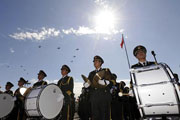 |
||
|
Biggest, best military band of National Day parade puts on show |
First three-service women formation debuts in military parade |
EQUIPMENT IN SPOTLIGHT
The most eye-catching weapons paraded were five types of missiles of the Second Artillery Force (SAF), China's core force of strategic deterrence, including China's most sophisticated nuclear-capable intercontinental missiles.
The gigantic weapons in camouflaged colors, brining up the rear of all the equipment phalanxes, rolled on long-bed trucks, triggering exciting cheers and applause from spectators at the Tian'anmen Square.
 |
 |
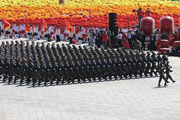 |
Zhang Guangzhong, commander of the phalanx, told Xinhua that the strategic missile on display is the country's newest model of nuclear-capable missile and has been deployed in recent years.
"Compared with its previous model, the missile responds (to emergencies) more rapidly, has longer fire range and greater maneuvering ability," he said, without giving specifics.
SAF's land-based cruise missile also made its debut at the once-in-a-decade military parade. The missile is able to perform long-range low-altitude precision strikes.
Also on rare public display were SAF's three types of conventional missiles.
China started to develop strategic missile weapons in 1956. Over the past decades, the SAF has grown into "a lean and effective strategic force with both nuclear and conventional missiles, capable of both land-based strategic nuclear counterattacks and precision strikes with conventional missiles," a White Paper on National Defense released last January said.
Despite the improvement of its nuclear-capable weapons, China has repeatedly assured the world that it pursues "a self-defensive nuclear strategy."
|
|
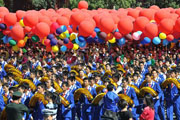 |
|
"We have adhered to the policy of no-first-use of nuclear weapons at anytime and under any circumstance, and made the unequivocal commitment that we will unconditionally not use or threaten to use nuclear weapons against non-nuclear-weapon states or nuclear-weapon-free zones," President Hu said last week in a speech at the U.N. Security Council nuclear summit in New York.
The parade also displayed advanced weapons of the Navy, including anti-ship missiles, ship-to-air missiles, ground-to-ship missiles and amphibious vehicles.
At the military parade to mark the 60th anniversary of China's Navy last April, China already displayed its nuclear submarine.
Other sophisticated weaponry on display included China's new generation of tanks, sophisticated radar, unmanned aerial vehicles and satellite communication devices.
 |
 |
|
Following the ground formations was a fly-over, featuring 151 warplanes ranging from China's most advanced fighter jets J-10 and J-11 to airborne early warning and control aircrafts, bombers, aerial tankers, and helicopters.
Sixty years ago when Chairman Mao Zedong reviewed the Chinese troops on the founding ceremony of the new China, only 17 warplanes, mostly seized from enemies in the Chinese War of Resistance Against Japanese Regression and the Liberation War against Kuomintang, joined the parade.
"With new fighter jets, airborne early warning and control aircraft, aerial tankers and a series of new air-to-air, air-to-ground, ground-to-air missiles, China's Air Force is forming a complete and advanced combat system," Professor Wang Mingliang with the Air Force Command College.
Liang Guanglie, minister of defense, said in an interview with Xinhua in late September that China's army has taken a historical step forward in weaponry and equipment over the past decades.
"We have had military-use satellites, advanced fighter aircraft in the air, newly designed tanks, cannons and missiles on land and advanced naval vessels and submarines at sea," Liang said.
"On the whole, we've already possessed all the equipment that western developed countries have. Many of our weaponry have reached or come close to the world-leading standards," he said.
 0
0 



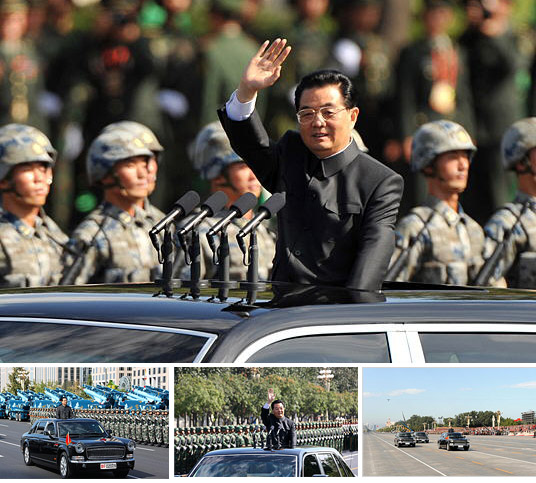


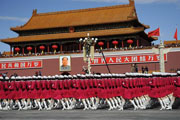
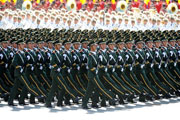
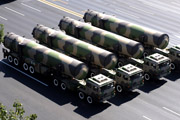




Comments